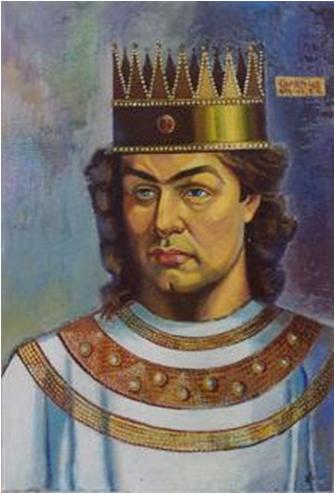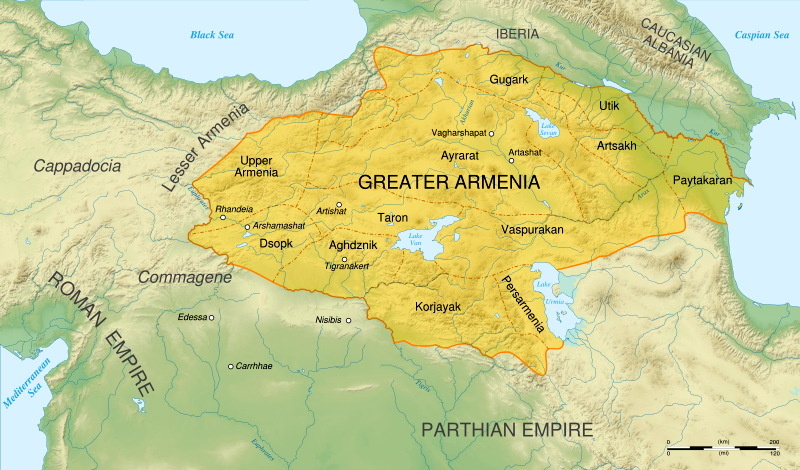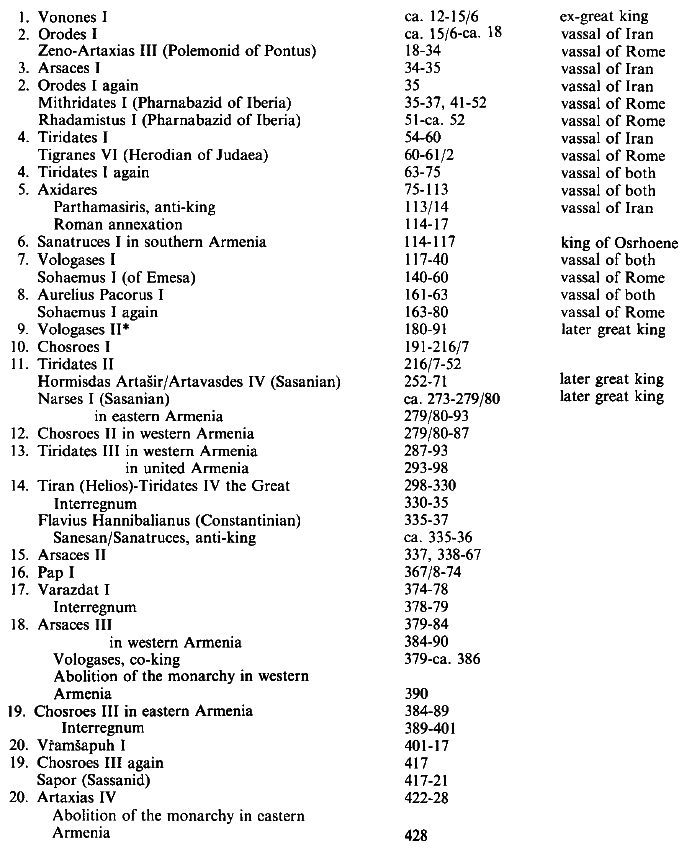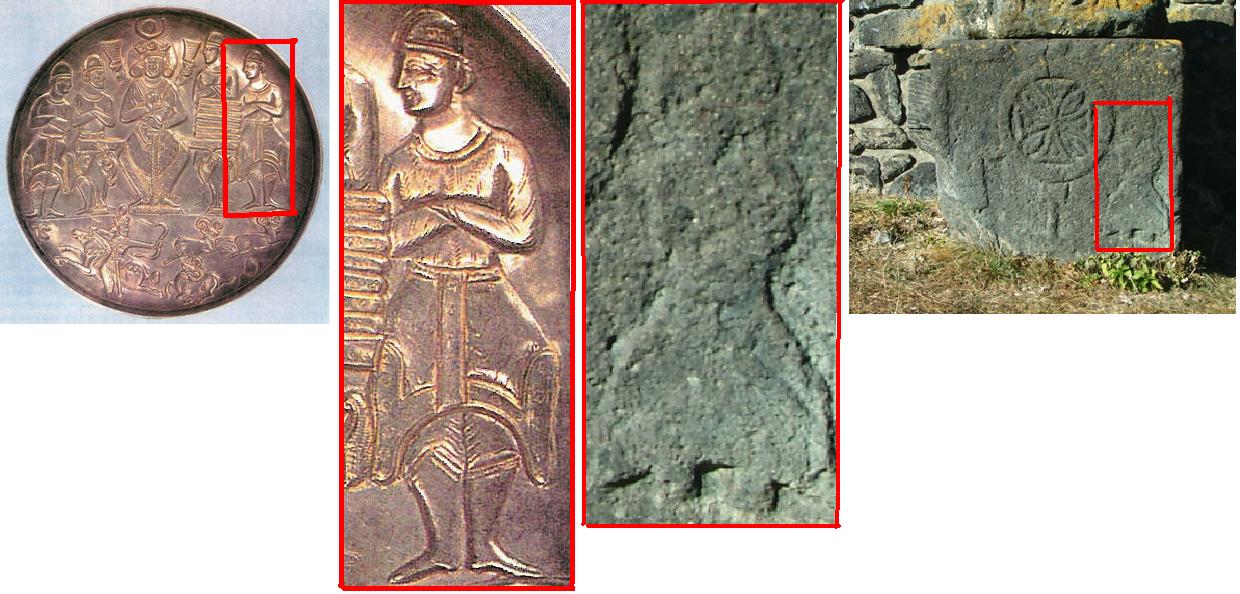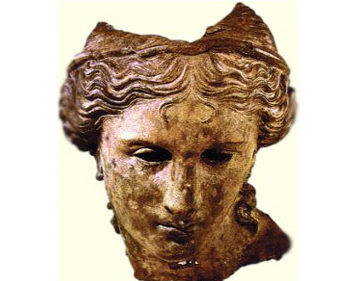The article below on the Arsacid Dynasty of Armenia is authored by Professor C. Toumanoff and was originally posted in the Encyclopedia Iranica). Kindly note that apart from the map and table of kings which have been posted on Encyclopedia Iranica and CAIS, all other pictures are unique to this posting.
=======================================================================
Third dynasty of Armenia (in Armenian, Aršakuni), from the first to the mid-fifth century. The preceding dynasty of the Artaxiads became extinct about A.D. 12, amid a secessionist chaos caused by the perennial struggle of Iran and Rome over Armenia—the second throne, after Media, in the Iranian scheme of vassal kingdoms. It was then that the ex great king of Iran, Vonones I became king of Armenia. After him, seven Arsacid princes from Parthia came at different times to occupy the Armenian throne, interchangeably with six others, candidates of Rome. A compromise was finally attempted in 63 (Treaty of Rhandeia).
An Arsacid, Tiridates I, was recognized by both empires as king of Armenia. Roman “friendship” was imposed upon him—and in 66 he journeyed to Rome to be crowned by Nero—and, at the same time, as a Parthian prince, he was bound to accept the family ascendancy of the head of the Arsacids, the great king. The balance thus established between political and dynastic allegiance proved, however, precarious. Dynastic allegiance often became political as well, and Armenia continued to oscillate between the two rivals. None of the first eight Arsacids who reigned in Armenia founded a line of kings; it was left to the ninth, Vologases (Vałarš) II (180-191), to achieve this: his posterity of thirteen kings formed the Armenian Arsacid dynasty (see table below). [Click to Enlarge] Arsacid Royal Lineage of Armenia (Picture Source: CAIS). The Armenian historical tradition (found chiefly in Ps.-Movsês Xorenac’i) represented the earlier, national Artaxiads as also a branch of the Iranian Arsacids, and the Armenian Arsacids as their direct continuation, creating thus an imbroglio from the effects of which Armenian historiography has only recently succeeded in freeing itself. Arsacid rule brought about an intensification of the political and cultural influence of Iran in Armenia. Whatever the sporadic suzerainty of Rome, the country was now a part-together with Iberia (East Georgia) and (Caucasian) Albania, where other Arsacid branched reigned-of a pan-Arsacid family federation. Culturally, the predominance of Hellenism, as under the Artaxiads, was now followed by a predominance of “Iranianism,” and, symptomatically, instead of Greek, as before, Parthian became the language of the educated. However. since the Iranian Arsacids themselves took pride in being philhellene, Armenian Hellenism was not destroyed. A portrait of Armenian King Varazdat (r. 374-378 CE) who was a descendant of the Parthian nobles of Armenia, known as the Arshakuni. After a while, however, the Armeno-Iranian symbiosis came to an end. Early in the third century. the Arsacids of Iran were overthrown by the Sasanians; the family federation existed no longer; instead, a family feud separated the Armenian Arsacids from the “usurping” new rulers of Iran. Next, in 314, under King Tiridates (Trdat) the Great and through the apostolate of ‘St. Gregory the Illuminator, Armenia, nearly simultaneously with the Roman empire. officially accepted Christianity, a turning point in its history. An unbridgeable gulf between the militant Mazdaism of Sasanian Iran and Armenia’s no less uncompromising Christianity, now replaced the unity of the easy syncretistic paganism of the Armeno-Iranian symbiosis. Politically, religiously, and culturally, this was a victory of the Roman empire and Hellenism. But this, the “neo-Achaemenianism” of the Sasanians could not tolerate. So the struggle of empires went on, more intensely than before, until, finally, the Roman empire, occupied elsewhere, was obliged to come to terms with Iran and to agree to the partitioning between them of the apple of discord, especially as, quite conveniently, the latter had just itself effected its division. [CLICK TO ENLARGE] PHOTO INSERT & COMMENTARY BY Kaveh Farrokh: Sassanian metalwork at right depicting Khosrow I Anoushiravan and four Sassanian knights (possibly the Sassanian empire’s primary generals). Note the stance of one of the knights from the plate highlighted for reference. Note the figure highlighted on the Surp Neshan Basilica – the parallels of this form (despite the wear of weather over the centuries) with its Sassanian counterparts are virtually exact. Parallel to the tension of imperial rivalries outside, there was also a tension at home, one between the crown and the great nobility. Armenia was a highly aristocratic society, its peculiar feature being the presence, above the lesser, azat nobility, of a group of dynastic princes, descendants and successors of prehistoric tribal chiefs, who regarded themselves as minor kings and the king of Armenia as a primus utter pares. The crown endeavored to enhance its ascendancy over the princes. In an attempt to replace the purely political subordination of sovereign princes to a more powerful sovereign, the king, feudalism was introduced, reaching its fullest development in the Arsacid period, with its fundamental conception of the derivation of all authority from the king. The princes, on their part, strove to preserve the older conception, their traditional dynastic position. Hence both conceptions coexisted, in a typically Armenian- and Caucasian- blend. Hence, also, the inner tension. So, while the crown was drawn towards the autocratic and bureaucratic empire. the princes, albeit Christians, gravitated towards the comparatively more aristocratic Iranian monarchy. During one of the internal crises, the kingdom was divided in 384 between the pro-Roman Arsaces (Arsak) III and the pro-Iranian Chosroes (Xosrov) IV. With this fait accompli before them, the Emperor Theodosius I and the Great King Shapur III hastened to ratify in 387 the existence of two Armenian kingdoms, one, western, a Roman, and the other, eastern and vastly larger, an Iranian vassal. Arsaces I11 died in 390 and the western kingdom became a part of the Roman empire; but the eastern kingdom (Persarmenia) continued to exist. The crown, however, was fatally weakened; and, finally, the princes, weary of all immediate authority over them, deposed with Iranian connivance the last king, Artaxias (Artâshês) IV in 428 and brought about the abolition of the monarchy. Thereafter Armenia was a part of the Iranian empire, with the princes as its sovereign oligarchs, vassals of the distant great king, whose suzerainty expressed itself in the presence of his viceroy (marzpan) and in the obligation of fealty and military aid imposed on them. Armenian depiction of Goddess Anahit – Armenian equivalent of the Goddess Anahita (Picture Source: News.Am). An event of importance in the Arsacid period was the invention on the threshold of the fifth century, of the Armenian alphabet by St. Mashtoc’ (Mesrop). With this Armenian became the language of the educated; it was introduced into the liturgy; and national literature was born (under Hellenistic and Syrian influences). Armenia’s identity and individuality were thus saved and an absorption by either Byzantine or Iranian civilization was precluded.

